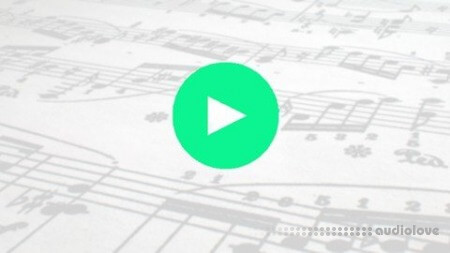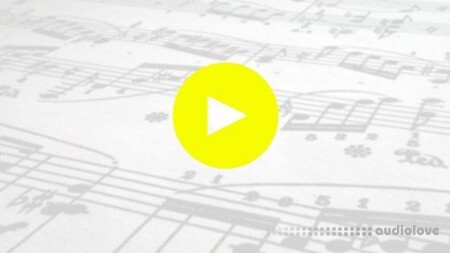Udemy Trinity Grade 4 Music Theory TUTORiAL

P2P | 30 October 2024 | 384 MB
This Grade 4 Music Theory video courses covers the Trinity syllabus in full.
Rhythm and Form
Time signatures of 5/8, 7/8 and 5/4
Rules for grouping note and rest values within 5/8, 7/8 and 5/4, (including grouping indications at the beginning of bars or scores, e.g. 2,3 or 3,2)
Harmonic rhythm (how fast chords change and whether regular or irregular)
Writing a rhythm to fit with words, writing words under a tune, and correcting mistakes in word setting (based on the rule that important words (or syllables) should be placed on the main beats of a bar)
Saying how many sections there are in a piece (form)
Pitch
Naming and using notes in alto clef
Eb and A major keys (for all major keys for the grade: scales, key signatures, one-octave arpeggios, broken chords and tonic triads (root, first or second inversion)
C and F# minor keys (for all minor keys for the grade: scales - natural (Aeolian mode) and harmonic and melodic, key signatures, one-octave arpeggios, broken chords and tonic triads (root, first or second inversion)
Inversions of tonic triads. Labelled:
— as a chord symbol above the music (e.g. C, C/E and C/G in the key of C major or Am, Am/C and Am/E in the key of A minor)
— as a Roman numeral below the music (e.g. I, Ib and Ic in the key of C major or i, ib and ic in the key of A minor)
Identifying the key of a piece in Eb or A major and C or F# minor
4th degree of the major/minor scale being known as the subdominant or fa (major keys only)
Subdominant triads for all keys covered so far
Major/minor subdominant and dominant triads labelled:
— as a chord symbol above the music (e.g. for subdominant, F in the key of C major or Dm (or D where the 6th degree is raised) in the key of A minor)
— as a Roman numeral below the music (e.g. for subdominant IV in the key of C major or iv (or IV where the 6th degree is raised) in the key of A minor
Recognising a plagal cadence in the home key (major or minor)
Enharmonic equivalents
Recognising chromatic scales or passages from chromatic scales
Intervals (augmented 4ths and diminished 5ths)
Concept of compound intervals
Understanding parallel 5ths and octaves
Dominant seventh chords of all keys covered so far
Dominant seventh chords labelled:
— as a chord symbol above the music (e.g. G7 in the key of C major or E7 in the key of A minor)
— as a Roman numeral below the music (e.g. V7 in the key of C major or V7 in the key of A minor)
Writing subdominant or dominant chords in root position in any key for the grade as well-balanced
4-part chords for SATB
Transposing a tune up or down a perfect 4th or 5th (within the keys for the grade) or for a transposing instrument for the grade
Recognising and writing unaccented passing notes
Ranges (and transposing intervals where appropriate) of French horn, descant recorder, oboe, viola, double bass and guitar as defined in the workbook
Knowing which families the above instruments come from (brass, woodwind, string)
Musical terms and symbols
home page:
https://goo.su/Cdgng9H
DOWNLOAD
Related News:
 Udemy Trinity Grade 6 Music Theory TUTORiAL
Udemy Trinity Grade 6 Music Theory TUTORiALP2P | 26 October 2024 | 778 MB A complete course covering the Trinity Grade 6 Music Theory syllabus. Rhythm, Texture and Form Demisemiquaver triplets (32nd note triplets)...
 Udemy Trinity Grade 5 Music Theory TUTORiAL
Udemy Trinity Grade 5 Music Theory TUTORiALP2P | 25 October 2024 | 333 MB This Grade 5 Music Theory video courses covers the Trinity syllabus in full. This course is for candidates preparing for Trinity Grade 5 Music Theory...
 Udemy Trinity Grade 3 Music Theory TUTORiAL
Udemy Trinity Grade 3 Music Theory TUTORiALP2P | 24 October 2024 | 256 MB This Grade 3 Music Theory video courses covers the Trinity syllabus in full. Rhythm Compound time (time signatures of 6/8, 9/8 and 12/8 )...
 Udemy Complete Course: Scales and Arpeggios for Piano and Keyboard TUTORiAL
Udemy Complete Course: Scales and Arpeggios for Piano and Keyboard TUTORiALP2P | 27 January 2024 | 5.9 GB Welcome to this complete Scales for Piano and Keyboard Course written for piano and music beginners. I'm RL your instructor, and I'll show you how to play scales on a piano or keyboard, and also bring you behind the scene to understand why you are playing the scales and arpeggios this way!...
Comments for Udemy Trinity Grade 4 Music Theory TUTORiAL:
No comments yet, add a comment!